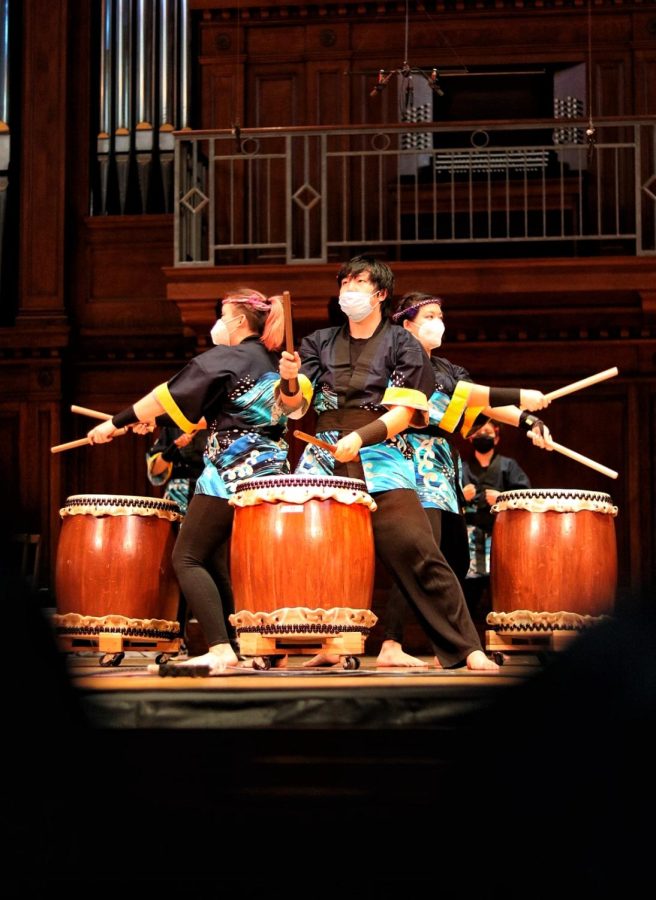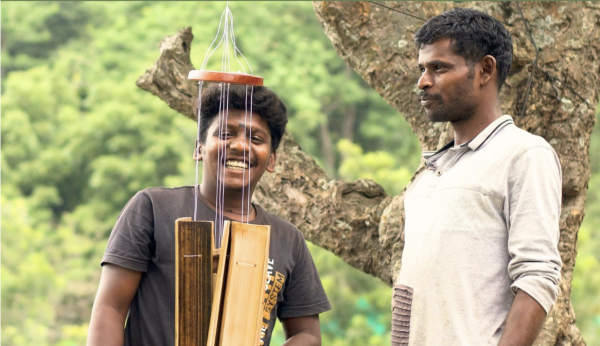Return of Colors of Rhythm Revitalizes Cherished Tradition
Colors of Rhythm, one of the Multicultural Resource Center’s most anticipated events, returned to campus for the first time since the onset of the pandemic.
Colors of Rhythm, one of the Multicultural Resource Center’s most celebrated annual events, returned to the Finney Chapel stage for the first time in two years. Colors of Rhythm was founded in 1997 by Oberlin students in conjunction with the MRC, and seeks to highlight and celebrate the talent of student-artists and performers of color.
This year’s show saw performances from a wide range of students and student organizations including OSLAM, African Students Association, And What!?, South Asian Students Association, and Oberlin College Taiko.
The energy in the chapel was palpable as Conservatory third-year Rachel Yee took the stage for the first act to cheers and applause, which grew louder with each performance. Throughout the night, students sitting shoulder to shoulder in the crowded pews relished in the sheer magnitude of talent on display.
The event has served as a sanctum for Oberlin students of color for the last quarter of a century, but what made this year’s show stand out was its role in reintroducing many younger Obies to the massive expanse of multicultural artforms on campus after two years of relative silence due to the COVID-19 shutdown.
College fourth-year Ryo Adachi was introduced to Colors of Rhythm as a first-year in 2019, the last year it was produced before the pandemic.
“I remember participating in the 2019 one,” she said. “It really was a nice platform for students to share and celebrate the different kinds of cultures and creativity on campus.”
Adachi described the buzz about the event she heard as a first-year, which made her want to get involved.
“[I heard] a lot of upperclassmen talking about the event, even from Orientation actually, and they were really excited,” she said. “I think that was definitely a shift on campus over the past two years where it didn’t happen and not many people now know about it, so hopefully we can bring back the tradition so that people know about it and celebrate it.”
Adachi’s eagerness to bring Colors of Rhythm back to the student body was a sentiment shared by College second-year Arohi Dandawate, who danced on Thursday both with the Bollywood/Bhangra ExCo and in a duet with College third-year Aiesha Parmar.
“As we start to bring back these performances, I get that feeling of, ‘This is why I’m doing this,’” Dandawate said. “Practicing alone is really meditative and awesome, but doing things as a group, doing things for other people to enjoy and to learn, is just such an uplifting feeling.”
She and Parmar danced together to a popular song from the Bollywood movie Devdas, which Parmar explained was a very important experience for them.
“It’s a song that has a place in the hearts of a lot of Bollywood dancers,” Parmar said. “I remember being obsessed with the song when I was like four years old and wanting to dance like them, and now I’m actually doing it.”
In spite of the long hiatus, the significance of Colors of Rhythm to Oberlin students of color has certainly not been lost.
“The default in Oberlin tends to be white,” Parmar said. “You have to go out of your way to find cultural diversity classes to learn from perspectives outside of that, so it’s nice to have this event that centers and celebrates the global majority.”
Conservatory fourth-year Gabriel Morales, who also performed at the showcase, shares a similar view.
“In my case, as a child of Venezuelan parents, I don’t often have a space to include influences from my family’s culture in the styles of music I normally perform in an overt way,” Morales wrote in an email to the Review.
Morales performed with College third-year Bianca Berger as they played “Gade Papi” by Emeline Michel, a Hatian vocalist and songwriter, and recited an original poem by Berger titled “To Dream.”
For Morales, the song signifies a call to follow your passions and ignore anyone’s threats to your inner fire. That message seems particularly relevant to students like double-degree fifth-year Morgan Chan, who performed with OC Taiko at the event.
“As someone who’s in the Conservatory, I do sometimes feel a little bit closeted about also playing Taiko,” Chan said. “It tends to be viewed as a hobby, … which made me feel discouraged about being more open about what I cared about and who I was.”
OC Taiko performed two pieces at the event, an arrangement of a specific stance and form taught by Oedo Sukeroku Daiko called “Many-Sided” and a piece first written by Hiroshi Tanaka called “Tatsumaki.” The crowd erupted as soon as the performers took their places, staring in awe as they masterfully flew across the stage in perfect time.
In the week leading up to Colors of Rhythm, Chan looked forward to the opportunity to perform in a space that placed much more value on artforms like Taiko.
“I think it’ll be nice to play for an audience that is more open and accepting,” they said. “[And] it’s not just about accepting people of color, it’s also about celebrating them.”
The goal of the event is, of course, to provide a space for performers of color, but the main hope of the students and the MRC is that it will be just one of many spaces that open up as students’ talents and voices are seen and heard on a larger scale.
“It goes without saying that BIPOC art and stories are so important and it’s great that we are able to share that in such a big way through Colors of Rhythm,” Berger wrote in an email to the Review. “Support doesn’t stop at coming to see the show, however. It looks like going to and supporting BIPOC events that orgs put on themselves. It looks like supporting and being an ally in classes and in public spaces like the ’Sco. Allyship comes in many forms and people across the board should really sit with and reflect on how they can be in physical space with those they want to support without centering themselves.”











